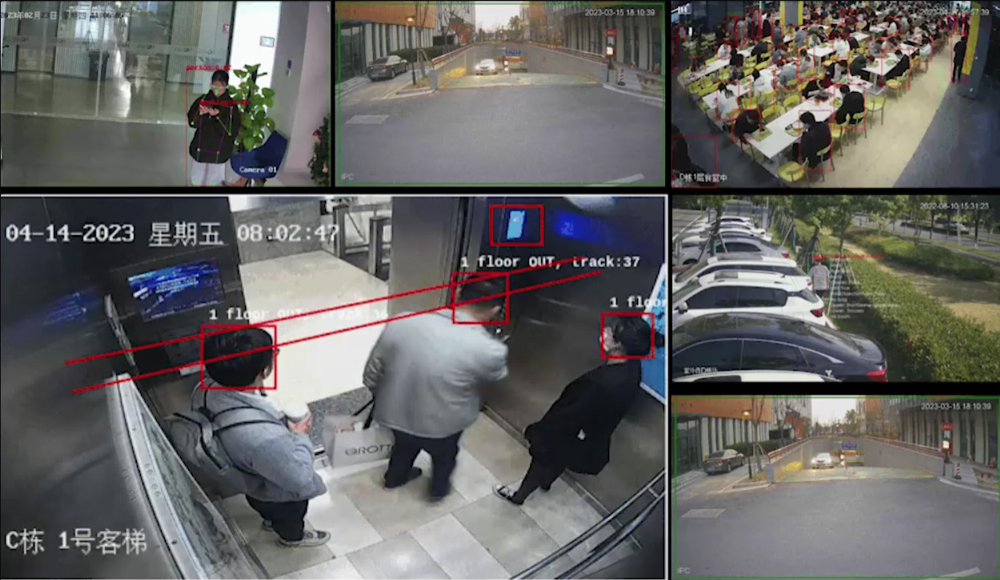
Built-in diverse real-world datasets
Hybrid annotation (manual + AI-assisted)
Distributed edge incremental learning for accelerated model iteration
Automated model quantization and conversion for rapid deployment

Proven use cases have yielded a core component library with industry-optimized functions
Visual drag-and-drop orchestration and personalized parameter tuning pipeline
Real-time, flexible, multi-dimensional effect validation
Edge device cluster authorization and one-click deployment

Edge-optimized model conversion and quantization for lightweight, high-performance deployment
Multi-task, multi-hardware flexible deployment
-
 Smart Park
Smart Park  Smart Retail
Smart Retail Smart Campus
Smart Campus  Smart Transportation
Smart Transportation

Project Background
In the smart park sector, the core requirements focus on video surveillance and facial analysis, primarily manifested in applications such as face recognition, restricted zone intrusion detection, crowd flow statistics, and video content feature extraction. These functions enable real-time target identification and attribute detection, facilitating data analysis and evaluation to ensure regional security.
Challenges
Fragmented long-tail scenarios with high customization costs;
Recognition accuracy affected by variable conditions (angles/lighting/background);
Massive device fleets requiring complex lifecycle management.
Solution Description
The on-premises full-stack AI training and development platform ensures data locality for privacy protection. It incorporates mature models and logical components, enabling rapid iterative training of new models and orchestration of functions such as crowd analytics, restricted-zone intrusion detection, phone-use recognition, illegal parking identification, smoking detection, license plate recognition, parking space monitoring, and key-person screening, allowing real-time verification to address dynamic AI requirements. All functions can be distributed to edge devices with a single click, with centralized cloud management for immediate response.
Project Background
In the smart retail sector, the focus spans three core dimensions: merchandise, space, and customers. Key capabilities include facial recognition, product identification, behavioral attribute analysis, customer flow statistics, and in-store tracking.
Challenges
Lack of data-driven insights leads to inefficient customer acquisition and low marketing conversion;
Highly fragmented data and disconnected online-to-offline consumer behaviors;
Legacy customized algorithms are costly, difficult to scale for widespread use, and entail lengthy deployment and after-sales cycles.
Solution Description
Leveraging industry-standard requirements and our full-stack AI development platform, we deliver all-in-one AI-powered smart store terminals through hardware-software co-design.
The hardware solution leverages micro-edge deployment to enable localized data processing and real-time decision-making tailored to the data-intensive nature of retail environments, effectively reducing costs associated with servers, storage, bandwidth, and physical space requirements.
The software platform comes preloaded with out-of-the-box retail algorithms for immediate deployment, while seamlessly integrating with cloud-based training and development systems to enable rapid customization of store-specific functions - including footfall analytics, customer attribute profiling, behavior pattern recognition, journey tracking, dwell time measurement, and table turnover rate monitoring - all deployable to edge devices with a single click. Its built-in model training module continuously iterates algorithms based on real-world data, enhancing recognition accuracy and supporting data-driven business decision-making.
Project Background
After the "Promoting Education Digitization" strategy was put forward in the report of the 20th National Congress of the Communist Party of China, educational innovation practices have continued to emerge. This strategy centers on roads (hardware facilities), vehicles (software platforms), cargo (educational resources), and drivers (teachers), with resources and data as the new elements. It deepens the application of intelligent technologies such as artificial intelligence, big data, and 5G, promoting the vertical deepening and horizontal integration of digital transformation, and contributing to the realization of a trinity of smart education ecology featuring digital connectivity, Internet of Things, and intelligent connectivity.
Challenges
Schools demand lightweight applications but face high maintenance costs and customization challenges;
Data silos and inconsistent standards hinder cross-tier data value extraction among schools;
Uneven resource allocation leaves AI talent concentrated in select institutions.
Solution Description
This initiative delivers a dual-pronged approach:
First, by integrating edge computing devices with our full-stack AI development platform, we create an all-in-one learning toolkit for university students that revolutionizes educational resource delivery. This solution enables schools to develop distinctive curricula while enhancing interactive teaching and learning experiences.
Second, for primary and secondary education, we implement cloud-edge-device collaborative systems to rapidly deploy functionality including misconduct detection, automated analytics, and posture assessment - streamlining academic administration, examination proctoring, and classroom management.
Project Background
Safety management is one of the core business requirements in industrial scenarios. Traditional safety inspections rely heavily on manual labor, resulting in poor efficiency in early warning and timely feedback for dangerous areas and behaviors.
Challenges
Fragmented long-tail use cases drive up customization costs and prolong development timelines;
Recognition accuracy is compromised by variable angles, lighting conditions, and complex backgrounds;
Massive device fleets entail extended deployment and maintenance cycles.
Solution Description
On-premises AI development platform deploys pre-trained models and modular components to rapidly configure functions including restricted-zone intrusion detection, phone-use recognition, smoking identification, behavior analysis, and fire/smoke detection – with real-time validation for accuracy assurance.
The platform automatically converts and quantifies models for edge deployment based on device specifications (brand/compute power), while enabling customized configurations including detection zones, electronic fences, tripwires, and parameter tuning – delivering cost-effective solutions for fragmented long-tail scenarios.
Edge devices perform real-time stream inference, output detection results, and report events to the cloud for centralized processing.
Project Background
The traffic management authority mandates comprehensive adoption of AI and big data technologies to establish an integrated urban traffic management system encompassing real-time perception, predictive analytics, and decision-making capabilities.
Challenges
Detection performance varies across scenes and lighting conditions;
The system must support large-scale data processing and analytics.
Solution Description
The on-premise EVEX AI training and development platform enables autonomous model training by ingesting real-world scenario data, utilizing built-in modular components to rapidly configure behavior detection, vehicle attribute recognition, and traffic flow analytics while performing operational analyses including congestion status, average speed, and time occupancy based on event reports.
Through edge device deployment, the solution meets strict machine latency requirements by processing data at source, ensuring uninterrupted service even during network instability, with open APIs facilitating detection output integration into third-party systems for unified analytics and management.
Founded in 2019, our team comprises 70+ R&D professionals with 85% holding master's degrees or higher. Since inception, we have successfully delivered 100+ projects across diverse industries including industrial parks, transportation, education, manufacturing, retail, and finance. Our project methodology centers on dual core principles: developing universal algorithms focused on "object recognition" while expanding application boundaries through "scenario adaptation." By leveraging core technical competencies in AI framework optimization, chipset heterogeneity, and business logic decoupling, we enable enterprises to achieve rapid, cost-effective, and scalable AI implementation. Our proven technical expertise and premium service delivery have established strong industry recognition and earned widespread acclaim.











